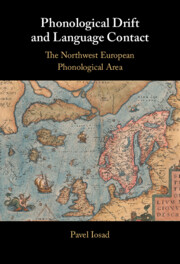Refine search
Actions for selected content:
138 results
Reassessing the areality of sociative causative markers: A South American feature
-
- Journal:
- Journal of Linguistic Geography , First View
- Published online by Cambridge University Press:
- 08 September 2025, pp. 1-12
-
- Article
-
- You have access
- Open access
- HTML
- Export citation
Phonetic variables in African Frenches: Social variation in Kinshasa French vowel systems
-
- Journal:
- Journal of French Language Studies / Volume 35 / 2025
- Published online by Cambridge University Press:
- 01 August 2025, e12
-
- Article
-
- You have access
- Open access
- HTML
- Export citation
Tracing contact and migration in pre-Bantu Southern Africa through lexical borrowing
-
- Journal:
- Evolutionary Human Sciences / Volume 7 / 2025
- Published online by Cambridge University Press:
- 23 July 2025, e25
-
- Article
-
- You have access
- Open access
- HTML
- Export citation
A PAT- on the back?: “Invisible” borrowing in Guernésiais
-
- Journal:
- Journal of French Language Studies / Volume 35 / 2025
- Published online by Cambridge University Press:
- 03 July 2025, e11
-
- Article
-
- You have access
- Open access
- HTML
- Export citation
8 - Conclusion: Summation, Causation, and the Future
-
- Book:
- The Balkan Languages
- Published online:
- 31 May 2025
- Print publication:
- 26 June 2025, pp 1009-1025
-
- Chapter
-
- You have access
- Open access
- HTML
- Export citation
Introduction
-
- Book:
- The Balkan Languages
- Published online:
- 31 May 2025
- Print publication:
- 26 June 2025, pp 1-10
-
- Chapter
-
- You have access
- Open access
- HTML
- Export citation
3 - Concepts, Theories, Methods
-
- Book:
- The Balkan Languages
- Published online:
- 31 May 2025
- Print publication:
- 26 June 2025, pp 97-178
-
- Chapter
-
- You have access
- Open access
- HTML
- Export citation
The productivity of the Complex Modifier Construction in World Englishes
-
- Journal:
- English Language & Linguistics / Volume 29 / Issue 2 / June 2025
- Published online by Cambridge University Press:
- 24 June 2025, pp. 389-410
-
- Article
-
- You have access
- Open access
- HTML
- Export citation

Phonological Drift and Language Contact
- The Northwest European Phonological Area
-
- Published online:
- 17 June 2025
- Print publication:
- 05 June 2025
The Landscape of English in Southeast Asia - Andrew J. Moody, ed., The Oxford Handbook of Southeast Asian Englishes Oxford: Oxford University Press, 2024. Pp. viii+864. Hardback £135, ISBN 9780192855282; e-book £112.50, ISBN 9780192667540
-
- Journal:
- English Today , First View
- Published online by Cambridge University Press:
- 13 June 2025, pp. 1-3
-
- Article
- Export citation
1 - Setting the Scene
-
- Book:
- Phonological Drift and Language Contact
- Published online:
- 17 June 2025
- Print publication:
- 05 June 2025, pp 1-14
-
- Chapter
- Export citation
3 - Theoretical Background
-
- Book:
- Phonological Drift and Language Contact
- Published online:
- 17 June 2025
- Print publication:
- 05 June 2025, pp 31-58
-
- Chapter
- Export citation
2 - Research Context
-
- Book:
- Phonological Drift and Language Contact
- Published online:
- 17 June 2025
- Print publication:
- 05 June 2025, pp 15-30
-
- Chapter
- Export citation
8 - Preaspiration and Language Contact
-
- Book:
- Phonological Drift and Language Contact
- Published online:
- 17 June 2025
- Print publication:
- 05 June 2025, pp 220-254
-
- Chapter
- Export citation
Introduction
-
- Book:
- Phonological Drift and Language Contact
- Published online:
- 17 June 2025
- Print publication:
- 05 June 2025, pp xvii-xx
-
- Chapter
- Export citation
Chapter 4 - English in Contact: From Code-Switching to the Birth of New Varieties
-
- Book:
- English Sociolinguistics
- Published online:
- 01 May 2025
- Print publication:
- 15 May 2025, pp 84-118
-
- Chapter
- Export citation
Revisiting the Syntax and Development of Kiezdeutsch V3: a New Perspective
-
- Journal:
- Journal of Germanic Linguistics / Volume 37 / Issue 1 / March 2025
- Published online by Cambridge University Press:
- 27 March 2025, pp. 64-124
-
- Article
-
- You have access
- Open access
- HTML
- Export citation
Between Anglomania and Anglophobia - Virginia Pulcini, The Influence of English on Italian Berlin, Boston: De Gruyter Mouton, 2023. Pp. xii+285. Hardback €114,95, ISBN 9783110754957; e-Book ISBN 9783110755114, freely available at https://doi.org/10.1515/9783110755114
-
- Journal:
- English Today , First View
- Published online by Cambridge University Press:
- 25 March 2025, pp. 1-2
-
- Article
- Export citation
Re-thinking Jōmon and Ainu in Japanese History
-
- Journal:
- Asia-Pacific Journal / Volume 20 / Issue 15 / August 2022
- Published online by Cambridge University Press:
- 14 March 2025, e2
-
- Article
-
- You have access
- Open access
- Export citation
Bilingual Vocabulary Development in Mexican Indigenous Infants: The Effects of Language Exposure from Home and Mothers’ Language Dominance
-
- Journal:
- Journal of Child Language , First View
- Published online by Cambridge University Press:
- 21 February 2025, pp. 1-25
-
- Article
-
- You have access
- Open access
- HTML
- Export citation
